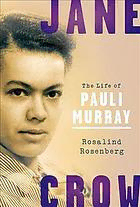
Jane crow - the life of pauli murray PDF
Preview Jane crow - the life of pauli murray
Jane Crow Jane Crow The Life of Pauli Murray ROSALIND ROSENBERG 1 1 Oxford University Press is a department of the University of Oxford. It furthers the University’s objective of excellence in research, scholarship, and education by publishing worldwide. Oxford is a registered trade mark of Oxford University Press in the UK and certain other countries. Published in the United States of America by Oxford University Press 198 Madison Avenue, New York, NY 10016, United States of America. © Oxford University Press 2017 All rights reserved. No part of this publication may be reproduced, stored in a retrieval system, or transmitted, in any form or by any means, without the prior permission in writing of Oxford University Press, or as expressly permitted by law, by license, or under terms agreed with the appropriate reproduction rights organization. Inquiries concerning reproduction outside the scope of the above should be sent to the Rights Department, Oxford University Press, at the address above. You must not circulate this work in any other form and you must impose this same condition on any acquirer. Library of Congress Cataloging-in-Publication Data Names: Rosenberg, Rosalind, 1946– author. Title: Jane Crow : the life of Pauli Murray / Rosalind Rosenberg. Description: New York, NY : Oxford University Press, 2017. | Includes bibliographical references and index. Identifiers: LCCN 2017000717 (print) | LCCN 2017000857 (ebook) | ISBN 9780190656454 (hardback) | ISBN 9780190656461 (Updf) | ISBN 9780190656478 (Epub) Subjects: LCSH: Murray, Pauli, 1910–1985. | African American intellectuals—Biography. | African American poets—Biography. | African American lawyers—Biography. | African American civil rights workers—Biography. | African American feminists—Biography. | Episcopal Church—Clergy—Biography. | Social reformers—United States—Biography. | Civil rights movements—United States—History—20th century | BISAC: BIOGRAPHY & AUTOBIOGRAPHY / Women. | BIOGRAPHY & AUTOBIOGRAPHY / Cultural Heritage. Classification: LCC E185.97.M95 R67 2017 (print) | LCC E185.97.M95 (ebook) | DDC 305.42092 [B]—dc23 LC record available at https://lccn.loc.gov/2017000717 1 3 5 7 9 8 6 4 2 Printed by Sheridan Books, Inc., United States of America For Gerald Alan Rosenberg (in memoriam) and Jeffrey John Parish CONTENTS Acknowledgments ix Abbreviations xv A Note on Pronouns and Other Word Choices xvii Introduction 1 PART I COMING OF AGE, 1910– 1937 1. A Southern Childhood 9 2. Escape to New York 31 PART II CONFRONTING JIM CROW, 1938– 1941 3. “Members of Your Race Are Not Admitted” 63 4. Bus Trouble 78 5. A Death Sentence Leads to Law School 97 PART III NAMING JANE CROW, 1941– 1946 6. “I Would Gladly Change My Sex” 115 7. California Promise, 1944–1946 140 vii viii Contents PART IV SURVIVING THE COLD WAR, 1946– 1961 8. “Apostles of Fear” 167 9. A Person In- Between 192 10. “What Is Africa to Me?” 219 PART V A CHANCE TO LEAD, 1961– 1967 11. Making Sex Suspect 241 12. Invisible Woman 266 13. Toward an NAACP for Women 286 PART VI TO TEACH, TO PREACH, 1967– 1977 14. Professor Murray 313 15. Triumph and Loss 333 16. The Reverend Dr. Murray 354 Epilogue 380 Notes 389 Bibliography 457 Index 471 ACKNOWLEDGMENTS The inspiration for this biography came from Ruth Bader Ginsburg, whom I met in 1974 at a Columbia University faculty seminar. I was a newly arrived assistant professor of history. Ginsburg, Columbia Law School’s first tenured woman pro- fessor, had already achieved fame as the country’s leading feminist legal advo- cate. Serving half-t ime as head of the Women’s Rights Project at the American Civil Liberties Union (ACLU), she had expanded the Supreme Court’s under- standing of the Fourteenth Amendment to protect not only against discrimina- tion based on race but also discrimination based on gender. As a young feminist, I wanted to understand the legal change Ginsberg was engineering; as a his- torian, I was curious about its roots. Over the next five years, until she left to become a judge on the Court of Appeals for the DC Circuit, and intermittently thereafter, Ruth patiently answered my questions. For many years, the knowledge she imparted made it no further than my classes in women’s and legal history. Then, in 1992, I included Pauli Murray, as the precursor to Ginsburg’s reinterpretation of the Fourteenth Amendment, in my book Divided Lives: American Women in the Twentieth Century. When I learned that Murray’s papers were being processed at the Schlesinger Library, I began research trips there that would last two decades. Many scholars helped me along the way. My Barnard colleague Nancy Woloch lived with this manuscript from beginning to end. Over lunch and in each other’s offices, she helped me think through any number of tricky interpre- tive problems. She read every word and offered astute criticisms, especially on sections that dealt with protective labor legislation. Susan Ware accepted my first essay on Murray in her collection of American biographies, Forgotten Heroes (1998). In 2002, she included my contribution on Murray’s concept of the “conjunction” of race and gender in a collection she called a “Dialogue” on Murray for the Journal of Women’s History. Most ix
